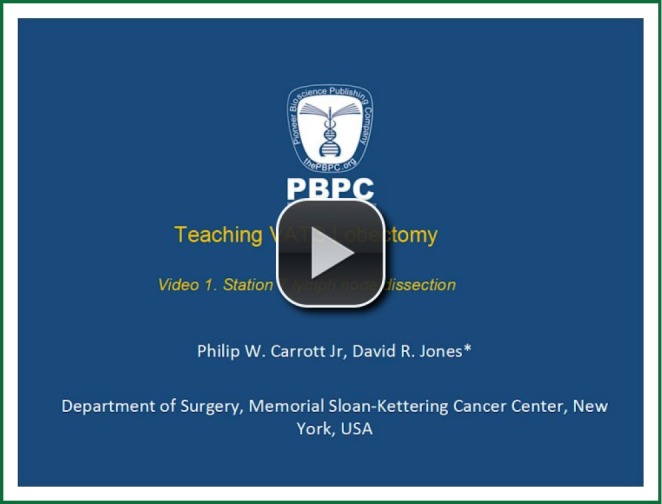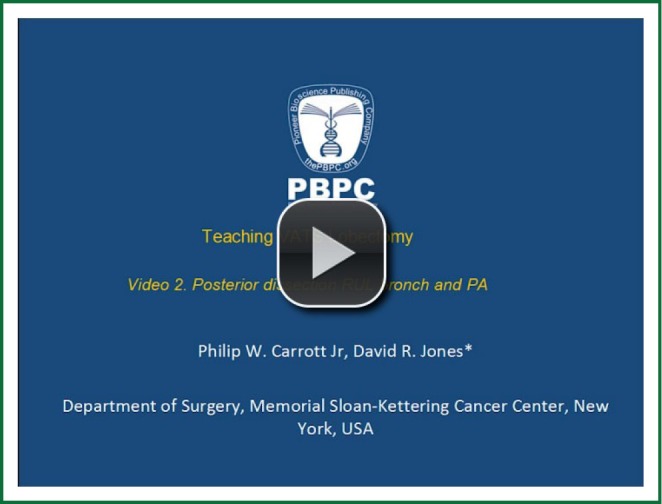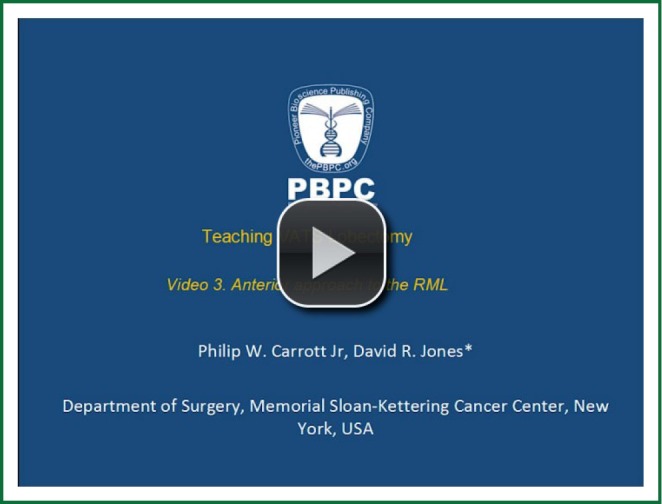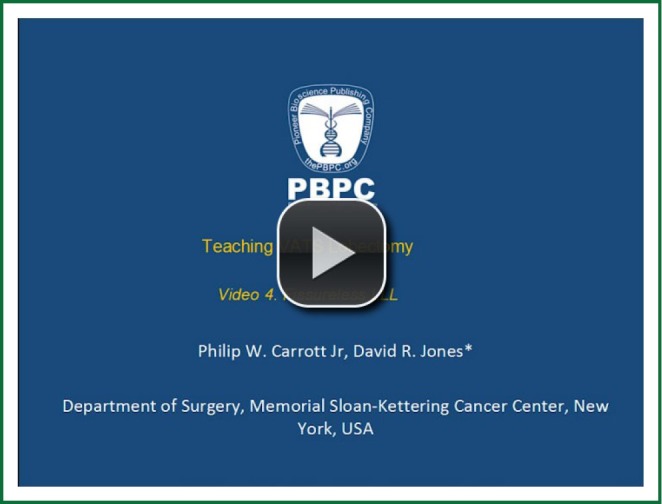Abstract
Video-assisted thoracic surgery (VATS) lobectomy has become the standard of care for early stage lung cancer throughout the world. Teaching this complex procedure requires adequate case volume, adequate instrumentation, a committed operating room team and baseline experience with open lobectomy. We outline what key maneuvers and steps are required to teach and learn VATS lobectomy. This is most easily performed as part of a thoracic surgery training program, but with adequate commitment and proctoring, there is no reason experienced open surgeons cannot become proficient VATS surgeons. We provide videos showing the key portions of a subcarinal lymph node dissection, posterior hilar dissection of the right upper lobe, fissureless right middle lobectomy, and fissureless left lower lobectomy. These videos highlight what we feel are important principals in VATS lobectomy, i.e., N2 and N1 lymph node dissection, fissureless techniques, and progressive responsibility of the learner. Current literature in simulation of VATS lobectomy is also outlined as this will be the future of teaching in VATS lobectomy.
KEY WORDS : video-assisted thoracic surgery (VATS) lobectomy, teaching, simulation
Introduction
Video-assisted thoracic surgery (VATS) lobectomy has rapidly become the standard of care for early-stage lung cancer treatment throughout North America and increasingly in the world. A VATS lobectomy is defined as the use of a 3-6 cm access incision without rib-spreading, one to three additional 1 cm ports, and the use of a thoracoscope to visualize the dissection and subsequent lobectomy. Compared to an open thoracotomy and lobectomy, a VATS lobectomy has equivalent oncologic results, less post-operative pain, shorter hospitalization, earlier return to activities of daily living, earlier administration of adjuvant therapies, and is less expensive (1,2). Despite these advantages there are several barriers to the adoption of more advanced VATS procedures including lobectomy. These include a lack of formal education and training, cost, lack of access to technology (particularly in non-North American or Western European countries), and a continued lack of education about the oncologic merits of the procedure relative to an open thoracotomy.
A recent survey of thoracic surgery residents reveals that 58% believe they are proficient in performing a VATS lobectomy at the completion of their residency program. Those individuals who were dedicated thoracic surgeons were much more likely (86%) to be comfortable performing a VATS lobectomy relative to those individuals with a mixed practice (28%) (3). Collectively, this suggests that there needs to more emphasis on introducing, teaching, and monitoring progression of the VATS lobectomy procedure to our trainees as well as those surgeons who are interested in incorporating the procedure into their existing practice.
There is an increasing literature on how advanced technologic procedures should be introduced into surgical practice (4-6). It is now well established that there is distinct learning curve for learning how to safely and proficiently perform a VATS lobectomy (4-9). The actual technical aspects of the procedure including number of incisions and methodologies to dissect and divide bronchovascular structures will vary amongst surgeons and are also dependent on the tumor stage and biology. For these reasons, the purpose of this review is to highlight important aspects of teaching and learning VATS lobectomy with an emphasis on programmatic requirements, patient selection, and strategies to facilitate the learning process, including simulation. We will also discuss some basic technical considerations that apply to all VATS lobectomy procedures.
Programmatic and individual requirements
McKenna describes several important pre-requisites relative to beginning a VATS lobectomy program (9). One the most important points is that the entire operating room team (nurses, scrub technicians, first assistants) need to be familiar with open procedures before attempting VATS lobectomies. In addition, there should be an adequate volume of lobectomies (>25/year) in the practice. The surgeon who is performing VATS lobectomy procedures should have done a relative large number of smaller VATS procedures (i.e., wedge resection, lymph node biopsies, etc.). In addition, the surgeon should have observed several “live” VATS lobectomies and, if at all possible, assisted in the operations. There is no substitute (i.e., simulation, workshop, or video) for actual experience when one is adopting a new surgical technique. Frequently, this requires more than one observation or active participation. In addition, the best approach is for the scrub and circulating nurses to have also observed a live case or two so they can also become familiar with the basics of the procedure. These individual and programmatic pre-requisites apply to both new thoracic surgery residents and more experienced surgeons who are adopting this technology to their practices.
An additional pre-requisite that is rarely mentioned is the need for the appropriate VATS instrumentation, endostaplers, and the necessary instruments should conversion to an open procedure be indicated. Failure to have the appropriate VATS instruments, thoracoscopes and monitors can result in inadvertent intraoperative injuries, prolong the case, increase conversion rates, and demoralize surgeon and team morale and interest in the procedure. We routinely use a 45° thoracoscope while others prefer a 30° or flexible tipped camera (10). These angled scopes offer the most versatility in providing alternate angles to view the anterior and posterior hilum without switching camera port access sites. Use of dissecting two-point scissors, needle holders, long Harken or Semb clamps, DeBakey clamps and axial handle forceps are all basic and required instruments to facilitate performing a VATS lobectomy.
The last pre-requisite is for the surgeon and the other team members to understand their responsibilities should the case require conversion from VATS to open procedure. It is extraordinarily rare to require conversion emergently as most complications, including major bleeding, can be managed with elective or urgent conversion maneuvers.
Intraoperative teaching
Incisions and surgeon positions
Once the patient is positioned, attention is given to selection of the appropriate locations of the incisions. We use a 5 mm thoracoscope and therefore place a small trocar in the 7th or 8th intercostal space (ICS) in the middle to posterior axillary line to guide subsequent incision placement. A 4 cm access incision is then made anteriorly in the 4th ICS for upper and middle lobectomies and in the 5th ICS for lower lobectomies. This incision needs to be quite anterior. A third 1 cm incision is then made depending on surgeon preference.
If the teaching surgeon is going to stand posteriorly at the patient’s back, then it is easier to teach, guide, and first assist if the third incision is placed posterior to the camera port. If the teaching surgeon is going to stand anteriorly on the same side as the learner, then the third 1 cm incision is best placed anterior to the camera port. We prefer to have the teaching surgeon stand posteriorly and the learner stands anteriorly. We typically do not place trocars in these third incisions and thus only need a 5 mm trocar for the entire procedure. Additional ports are placed at the discretion of the surgeon. All ports should be separated by 6-8 cm in order to avoid unnecessary fencing of intrathoracic instruments. In teaching VATS lobectomy, as with other cases, there is a progression of responsibility for the case.
It is important to remember that an open lobectomy is typically performed via a posterior approach while a VATS lobectomy is almost always an anterior approach. Thus, a VATS lobectomy offers a “different view” for many surgeons. A final caveat is that if a two- or three-incision VATS lobe strategy is used, then the operating surgeon will need to operate more exclusively through the anterior access incision and therefore will most certainly need the full armamentarium of VATS instrumentation.
The correct placement of the access incision and ancillary ports is one of the most critical aspects of performing a VATS lobectomy proficiently. One also needs to consider the patient’s body habitus, a history of prior intra-thoracic procedures, and other considerations (i.e., breast implants, pacemakers, etc.).
Lymph node dissection
We perform the mediastinal nodal dissection first when performing a VATS lobectomy. Routine nodal dissection for right-sided tumors includes stations 2R, 4R, 7, and 10R. For left sided tumors we dissect stations 5, 7, and 10 L and station 6 if we observe a node in that region. Teaching the learner to dissect all the nodal tissue while avoiding bronchopulmonary structures as well as the superior vena cava (SVC), esophagus, and vagus, phrenic, and recurrent laryngeal nerves, is terrific first step in the learning process. This exposes the learner to much of the anatomy from an anterior approach as well as the various lung positioning and retraction maneuvers to facilitate the nodal dissection. While not routine, there are maneuvers that can be done to facilitate the N2 nodal dissection for the novice VATS lobe surgeon. For instance, division of the azygous vein at the junction of the SVC facilitates the dissection of 2R and 4R nodal stations.
We routinely begin our nodal dissection by retracting the lung anteriorly to completely dissect of station 7 (Video 1) and the posterior station 10L nodes. When indicated for more anteriorly located right upper lobe tumors or tumors near the minor fissure, it is also possible to begin to isolate and divide lobar bronchovascular structures from this posterior approach, as outlined in Video 2. In these cases the right upper lobe bronchus is isolated and divided first followed by the truncus arterial branch next, with the remainder of the segmental pulmonary arterial vessels and lobar veins taken from a continued posterior approach or from an anterior approach.
Video 1.

Station 7 Lymph node dissection. We prefer to start our procedure with this posterior hilar dissection and removing N2 nodes during the initial dissection. The sub-carinal lymph nodes are removed as a packet whenever possible.
Video 2.

Posterior dissection RUL Bronch and PA. The bronchus and first pulmonary artery branch are dissected and divided from the posterior approach. This may be necessary for large anterior tumors that prevent anterior visualization.
Teaching the N1 nodal dissection can be challenging for both the instructor and the learner. Notwithstanding the oncologic benefit, it is imperative that all N1 nodes be removed in order to facilitate the accurate identification of the lobar bronchi and perhaps more importantly the segmental branches of the pulmonary artery. We prefer a combination of blunt (metal suction device) and sharp dissection with either scissors or low-dose cautery to remove these nodes. The primary difficulty the learner has when performing a N1 dissection is the loss of haptic perception. Intraoperative teaching of this aspect of the procedure is best done by (I) having the correct VATS instrumentation; (II) explaining normal and common variant anatomy; and (III) moving anterior to posterior in the nodal dissection. Analysis of the STS database for upstaging of pulmonary malignancies following either VATS or open lobectomy found that significantly fewer N1 nodes were obtained following VATS lobectomy, indicating that VATS surgeons need to be more complete in sending N1 nodal tissue (11). The routine dissection and removal of the N1 lymph nodes makes subsequent isolation and division of the segmental pulmonary arteries with the endostapler much more expeditious and safer.
Fissureless VATS lobectomy
The majority of VATS lobectomies do not require identification of the pulmonary artery in the fissure and thus division of the parenchyma is commonly the last step of the procedure. This fissureless approach is best taught during open thoracotomies for lobectomies. We perform a fissureless VATS lobectomy in the majority of cases. As shown in Video 3 (a VATS middle lobectomy) and Video 4 (a VATS left lower lobectomy) a fissureless approach is simple, straightforward and in my opinion is less likely to result in injury to segmental pulmonary arterial branches. On occasion partial division of a fissure may facilitate the dissection and when appropriate should be performed. In addition, an experienced VATS surgeon will occasionally need to dissect vascular structures in the fissure to safely remove centrally-located or large tumors. These types of operations are not, however, appropriate beginning cases for the novice VATS lobectomy surgeon.
Video 3.

Anterior approach to the RML. Right middle lobectomy is performed in a “Fissureless” technique, taking the hilar vessels and bronchus first, then the fissures to perform the lobectomy.
Video 4.

Fissureless LLL. The key steps of a fissureless left lower lobectomy are shown. Smaller portions of the dissection are shown to keep the video short.
In general, when teaching a fissureless approach the pulmonary vein is isolated and divided first. This is a relatively simple maneuver most of the time and one that an intermediate learner can do within 10-15 minutes. Once complete it offers exposure to the lobar bronchus (lower and middle lobectomies) and pulmonary arterial segmental vessels. Each successive division opens up the dissection of the next structure, until the fissures are the only remaining attachments. We find that dissection and confirmation with various instruments that mimic the angles of the stapling devices are helpful in orienting subsequent endostapler application. We utilize the VATS curved and straight DeBakey clamps to approximate the angles one must have for the endostaplers.
Case progression
When teaching any new surgical technique there needs to be a progression toward independence for all steps of the procedure. In general, one can divide the steps in a VATS lobectomy into discrete, defined maneuvers (see Table 1 example). The learner and the instructor can both track progress, operative times per maneuver, and technical results and then make necessary adjustments on this data.
Table 1. Incremental steps of a VATS right upper lobectomy (RUL).
| (I) Correct placement of the access incision, thoracoscope and additional ports; |
| (I) Inspection and retraction of lung; |
| (I) Dissection of 7, 4R, 2R and 10R nodal stations; |
| (II) Incision of posterior mediastinal pleura to expose the right mainstem and upper lobe bronchi; |
| (III) Dissection of the sump node at the junction of the RUL bronchus and proximal bronchus intermedius; |
| (IV) Incision of the anterior mediastinal pleura and isolation and division of the superior pulmonary vein; |
| (V) Isolation and division of the truncus anterior and posterior ascending pulmonary arteries; |
| (VI) Removal of peribronchial nodal tissue followed by isolation and division of the RUL bronchus; |
| (VII) Division of the lung parenchyma; |
| (VIII) Placement of the RUL specimen into an endocatch bag followed by removal from the pleural cavity; |
| (IX) Apposition of the RML to the RLL to prevent a RML torsion syndrome (if indicated). |
Simulation and VATS lobectomy
Advanced minimally-invasive procedures such as a VATS lobectomy require a specialized surgical skill set. Surgical simulation may be able to facilitate a more rapid and safe introduction into surgical practice without exposing the patient to unnecessary risk. There are a number of relevant issues regarding simulation in thoracic surgery including identification of an appropriate and realistic model (computer-based, animal, or tissue block) and validation of the model (12-15). As outlined by Tong et al. the utility of a task-based simulator depends on its fidelity and validity. Fidelity, also known as face validity, refers to how real the simulator experience feels to the student. Content validity evaluates whether the steps performed in the simulator are accurate to what is done in the actual procedure. Construct validity evaluates the ability of the simulator to discriminate between learners at different levels of experience (14).
Groups at the University of North Carolina at Chapel Hill and New York University have developed a porcine-block and a virtual reality trainer VATS lobectomy model, respectively (13,15). The porcine lung block model has been shown to have a high fidelity and is perhaps the best studied and most validated model for teaching VATS lobectomy (14,15). The porcine block left lung model is not anatomically identical to human anatomy, but the tissue and advanced dissection techniques are reproducible and are detailed in an evaluation by senior surgeons (15). Additional groups have developed simulators for open surgery as well, which could be easily transitioned to VATS (16).
The virtual trainer has advantages in ease of set-up and fidelity to human anatomic variants as well as the ability to improve the model as technology improves. The upfront costs are estimated to be $25,000-35,000 for required infrastructure and will need further development. The virtual reality trainer can score the movements of the surgeon, allowing users to track their progress and set benchmarks for resident progress (13). Validation studies of the porcine block model were performed by Tong et al. and showed that in 31 residents with varying experience with VATS lobectomy that this model discriminated well between novice, intermediate, and experienced VATS lobectomy surgeons (14).
In all likelihood, the use of both platforms will be advantageous at different points in thoracic surgery training and in learning the VAS lobectomy procedure. The virtual reality platform can be used as often as one likes, and would be a good starting point for novice VATS lobectomy surgeons. The porcine model can then be used once surgeons gain some operative experience and will facilitate the development of fine dissection skills and gain a “feel” for tissue strength with sharp and blunt dissection of hilar vessels. In the United States, thoracic surgery education and training is transitioning to shorter, integrated programs which will certainly need simulation to adequately prepare surgeons with a reduced time in training. Unfortunately, there is still no universally identified simulation model and exposure opportunities are varied and limited to individual institutions. A more uniform and accessible simulation strategy for teaching and learning the skills required to perform a VATS lobectomy is needed.
Acknowledgements
Disclosure: The authors declare no conflict of interest.
References
- 1.Grogan EL, Jones DR. VATS lobectomy is better than open thoracotomy: what is the evidence for short-term outcomes? Thorac Surg Clin 2008;18:249-58 [DOI] [PubMed] [Google Scholar]
- 2.Cajipe MD, Chu D, Bakaeen FG, et al. Video-assisted thoracoscopic lobectomy is associated with better perioperative outcomes than open lobectomy in a veteran population. Am J Surg 2012;204:607-12 [DOI] [PubMed] [Google Scholar]
- 3.Boffa DJ, Gangadharan S, Kent M, et al. Self-perceived video-assisted thoracic surgery lobectomy proficiency by recent graduates of North American thoracic residencies. Interact Cardiovasc Thorac Surg 2012;14:797-800 [DOI] [PMC free article] [PubMed] [Google Scholar]
- 4.Reed MF, Lucia MW, Starnes SL, et al. Thoracoscopic lobectomy: introduction of a new technique into a thoracic surgery training program. J Thorac Cardiovasc Surg 2008;136:376-81 [DOI] [PubMed] [Google Scholar]
- 5.Ng T, Ryder BA. Evolution to video-assisted thoracic surgery lobectomy after training: initial results of the first 30 patients. J Am Coll Surg 2006;203:551-7 [DOI] [PubMed] [Google Scholar]
- 6.Rocco G, Internullo E, Cassivi SD, et al. The variability of practice in minimally invasive thoracic surgery for pulmonary resections. Thorac Surg Clin 2008;18:235-47 [DOI] [PubMed] [Google Scholar]
- 7.Petersen RH, Hansen HJ. Learning thoracoscopic lobectomy. Eur J Cardiothorac Surg 2010;37:516-20 [DOI] [PubMed] [Google Scholar]
- 8.Belgers EH, Siebenga J, Bosch AM, et al. Complete video-assisted thoracoscopic surgery lobectomy and its learning curve. A single center study introducing the technique in The Netherlands. Interact Cardiovasc Thorac Surg 2010;10:176-80 [DOI] [PubMed] [Google Scholar]
- 9.McKenna RJ., Jr Complications and learning curves for video-assisted thoracic surgery lobectomy. Thorac Surg Clin 2008;18:275-80 [DOI] [PubMed] [Google Scholar]
- 10.Demmy TL, James TA, Swanson SJ, et al. Troubleshooting video-assisted thoracic surgery lobectomy. Ann Thorac Surg 2005;79:1744-52; discussion 1753. [DOI] [PubMed]
- 11.Boffa DJ, Kosinski AS, Paul S, et al. Lymph node evaluation by open or video-assisted approaches in 11,500 anatomic lung cancer resections. Ann Thorac Surg 2012;94:347-53; discussion 353 [DOI] [PubMed] [Google Scholar]
- 12.Meyerson SL, LoCascio F, Balderson SS, et al. An inexpensive, reproducible tissue simulator for teaching thoracoscopic lobectomy. Ann Thorac Surg 2010;89:594-7 [DOI] [PubMed] [Google Scholar]
- 13.Solomon B, Bizekis C, Dellis SL, et al. Simulating video-assisted thoracoscopic lobectomy: a virtual reality cognitive task simulation. J Thorac Cardiovasc Surg 2011;141:249-55 [DOI] [PubMed] [Google Scholar]
- 14.Tong BC, Gustafson MR, Balderson SS, et al. Validation of a thoracoscopic lobectomy simulator. Eur J Cardiothorac Surg 2012;42:364-9; discussion 369 [DOI] [PubMed] [Google Scholar]
- 15.Fann JI, Feins RH, Hicks GL, Jr, et al. Evaluation of simulation training in cardiothoracic surgery: the senior tour perspective. J Thorac Cardiovasc Surg 2012;143:264-72 [DOI] [PubMed] [Google Scholar]
- 16.Carter YM, Marshall MB. Open lobectomy simulator is an effective tool for teaching thoracic surgical skills. Ann Thorac Surg 2009;87:1546-50; discussion 1551 [DOI] [PubMed] [Google Scholar]


